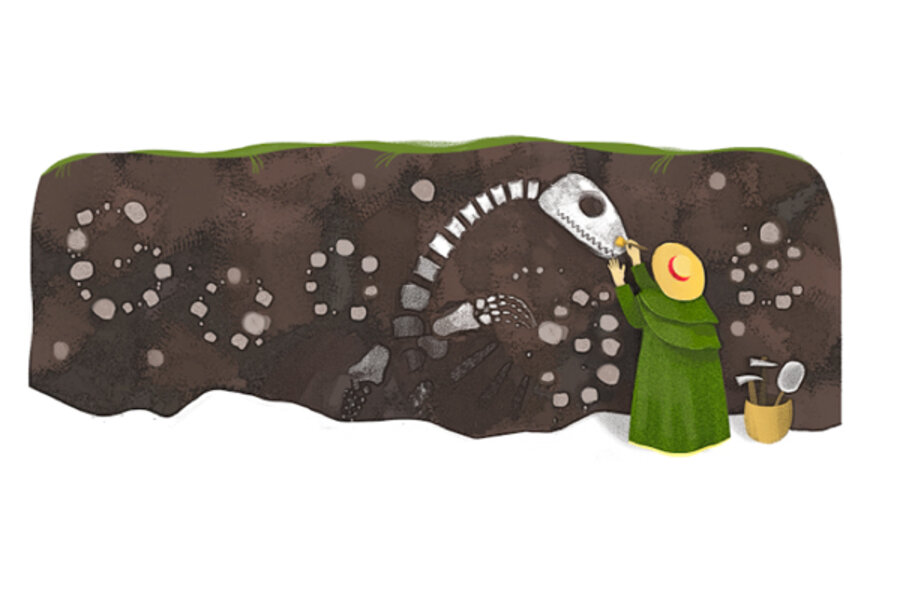Google celebrates Mary Anning with fossil-hunting doodle
Loading...
Imagine you are 12 years old and walking on a beach near the cliffs of Lyme Regis in England, looking for small fossils and shells that you can sell from your family’s curiosity stall. You notice something protruding from the side of the cliff, and begin digging the dirt away. As you continue, you realize it is a skull, and one that is far bigger than any of your smaller fossils. As it turns out, you’ve discovered the tip of one of the first known icthyosaurus dinosaur specimens.
This fortuitous trip to the beach actually happened to a 12-year-old in early 1800s: Mary Anning. Ms. Anning, a British paleontologist and fossil collector, ended up discovering, collecting, and dealing a vast array of previously unknown Jurassic-era skeletons and fossils that ended up in natural history museums around the world. Despite her sizable contributions, she was largely left un-credited due to her family’s status as religious dissenters and the fact that she was a woman. However, centuries later, she has been recognized as one of the founders of paleontology, and was honored with a Google Doodle on Wednesday on what would have been her 215th birthday.
Anning was born to a cabinetmaker and occasional fossil collector in Lyme Regis, England in 1799. Her family was quite poor and lived on the outskirts of society as religious dissenters who were practicing Congregationalists. Her father died when she was 11, leaving Anning and her brother, Joseph, to support the family largely through collecting fossils, or “curiosities” as they were then known, to sell to tourists who vacationed on the coast in summer months.
The cliffs near Lyme Regis are particularly rich in fossils from the Jurassic era, and the constant waves, landslides, and changing tides continue to uncover new specimens. It was there that Mary and her brother came upon the Icthyosaurus skull (a crocodile-like dinosaur), and later the rest of the skeleton, sticking out of a cliff wall. It was eventually sold to a local lord, who in turn sold it to the Museum of Natural Curiosities in London. This was the first time that Anning began to gain recognition outside her home community.
From there, Anning dug into the cliffs of Lyme daily, discovering the first near-complete plesiosaur (a long-necked sea dweller) which now hangs in London’s Natural History Museum, and a massive Temnodontosaurus platyodon specimen (another ferocious sea creature). She also found the first recognized pterosaur fossil (a reptilian bird the size of a giraffe) in England, as well as cuttlefish that still had some of its prehistoric ink preserved inside, which a friend used to paint illustrations of Annings’ findings. She used the money made from these discoveries to open a small curiosity shop in Lyme.
Though she found success on the cliffs, the society of 19th century England proved more difficult to crack. Dissenters from the Church of England at the time often faced discrimination, and were not allowed in universities or the army. Despite this, Anning was literate and often corresponded with other paleontologists and collectors of the time, even writing into the "Magazine of Natural History" when she spied a mistaken discovery that she could refute with fossils she found years earlier. Though museum dealers and collectors came from across Europe to visit her shop of fossilized treasures, they would often neglect to give her credit for the find when they displayed the specimens because she was a woman. The Geological Society of London, which was influential at the time, did not let women in as members or even join meetings as guests. A friend of hers wrote of Anning's frustration in a letter.
[Anning] says the world has used her ill ... these men of learning have sucked her brains, and made a great deal of publishing works, of which she furnished the contents, while she derived none of the advantages.
Despite these institutional difficulties, Anning found friends in leading geologists of the time, including Adam Sedgwick (who taught Charles Darwin) and Gideon Mantell (who discovered the iguanadon). She died at age 47 and was dedicated a panel of stained glass in her local church, as well as a eulogy by her friend and geologist Henry De la Beche, president of the Geological Society, a tradition normally reserved for members. Since then, her recognition has grown, culminating in the Royal Society of Britain naming her one of the ten most influential women in the history of science in 2010.
Her work had even attracted the attention of author Charles Dickens, who was editing the literary magazine “All the Year Round” at the time. His essay on her life included an ode to her humble beginnings and sizable contributions.
"The carpenter's daughter has won a name for herself, and has deserved to win it."








